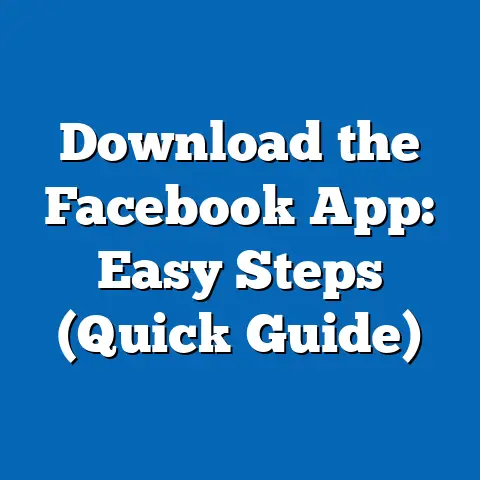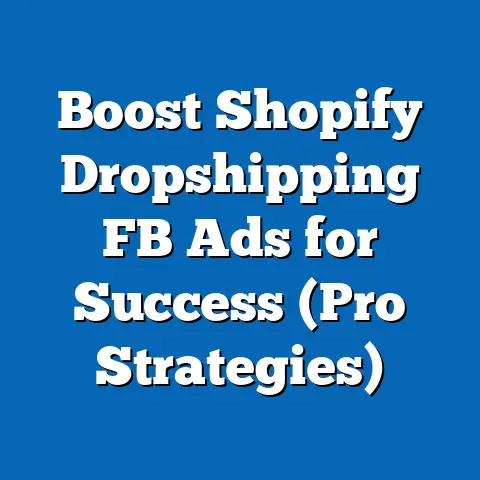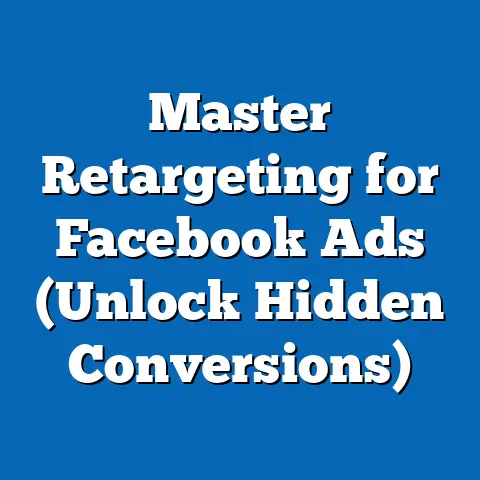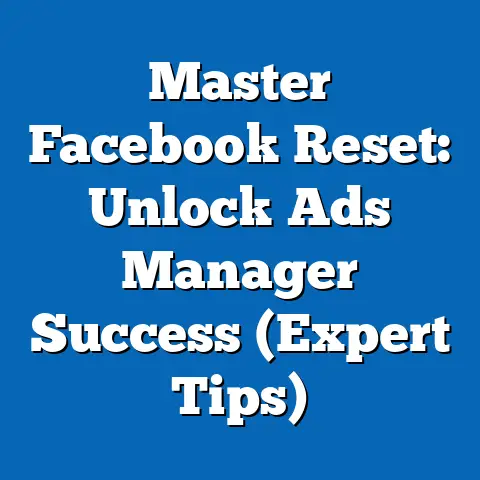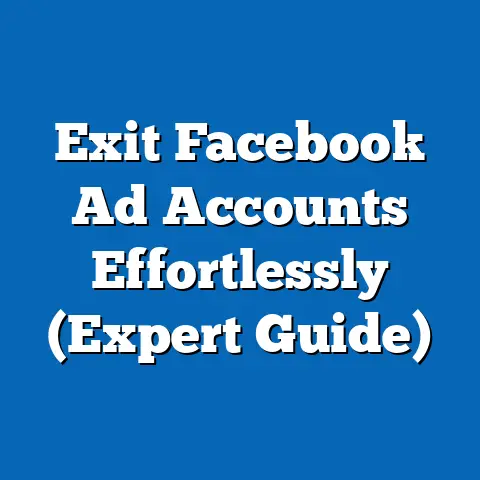Boost Facebook Ads Conversion Rates (Proven Strategies Inside)
Facebook. It’s a name practically synonymous with the internet itself. From its humble beginnings as a college social network to its current status as a global advertising powerhouse, Facebook has consistently reinvented itself. And despite the ever-changing digital landscape and the rise of new platforms, Facebook remains a cornerstone for businesses looking to leverage digital advertising. I’ve seen it firsthand, working with countless clients over the years – Facebook, or rather Meta, still delivers.
But here’s the truth: simply running Facebook ads isn’t enough. Many marketers struggle to convert their ad spend into tangible results. They see impressions, clicks, even some engagement, but the actual conversions – sales, leads, sign-ups – remain stubbornly low. That’s where this article comes in. I’m going to share proven strategies, tactics that I’ve personally used and seen work time and again, to significantly enhance your conversion rates on Facebook ads. Get ready to dive into actionable, evidence-based techniques that can transform your Facebook advertising game.
Understanding Conversion Rates
Let’s start with the basics. What exactly is a conversion rate? In the context of Facebook advertising, a conversion rate is the percentage of people who click on your ad and then complete a desired action, also known as a conversion. This action could be anything from making a purchase on your website to filling out a lead generation form, downloading an ebook, or signing up for a newsletter.
Why are conversion rates so important? Simply put, they’re the key to unlocking a positive return on investment (ROI) from your Facebook advertising. Think of it this way: you can have the most beautiful ad in the world, but if it doesn’t lead to conversions, it’s essentially a pretty picture costing you money. High conversion rates mean you’re getting more value out of every dollar you spend on advertising. They directly translate to increased revenue, more leads, and ultimately, greater overall marketing success.
Several factors influence conversion rates on Facebook. These include:
- Audience Targeting: Are you showing your ads to the right people? Irrelevant ads won’t convert.
- Ad Creative: Is your ad visually appealing and does it clearly communicate your value proposition?
- Landing Page Experience: Does your landing page match the ad’s message and provide a seamless user experience?
- Offer & Value Proposition: Is your offer compelling and does it clearly demonstrate the value you provide to potential customers?
I’ve seen companies double, even triple, their sales simply by focusing on improving their conversion rates. For instance, I worked with an e-commerce brand selling handmade jewelry. They were running Facebook ads but their conversion rates were abysmal. After carefully analyzing their data, we realized their targeting was too broad and their landing page was confusing. We refined their audience to target people with specific interests in handmade jewelry and redesigned their landing page to be more user-friendly. The result? Their conversion rates skyrocketed, leading to a 150% increase in sales within a month!
Key Takeaway: Conversion rates are the lifeblood of successful Facebook advertising. Understanding what they are, why they matter, and the factors that influence them is the first step toward boosting your results.
Targeting the Right Audience
Imagine shouting into a crowded stadium, hoping someone will hear your message. That’s what broad, untargeted Facebook advertising feels like. You’re wasting energy and resources on people who simply aren’t interested in what you have to offer. Precise audience targeting is the key to making your ads resonate with the right people and drastically improving your conversion rates.
Facebook offers a wealth of audience targeting options, allowing you to narrow your focus and reach the individuals most likely to convert. Here’s a breakdown of some of the most powerful tools:
- Custom Audiences: This is where you upload your own data, such as customer lists, email addresses, or website visitors, to create highly targeted audiences. I’ve found Custom Audiences to be incredibly effective for retargeting past customers or nurturing leads who have already shown interest in your business.
- Lookalike Audiences: This feature allows you to find new customers who share similar characteristics with your existing customers. By analyzing the traits of your best customers, Facebook can identify other users who are likely to be interested in your products or services. I often use Lookalike Audiences to expand my reach and find new potential customers who fit my ideal customer profile.
- Detailed Targeting: This option allows you to target users based on their demographics (age, gender, location, education), interests (hobbies, passions, activities), and behaviors (online shopping habits, travel preferences, device usage). Detailed Targeting gives you granular control over who sees your ads.
Refining your audience targeting is an ongoing process. A/B testing different audience segments can help you identify the most responsive groups. For example, you can test different age ranges, interests, or behaviors to see which combination yields the highest conversion rates. I remember working with a local bakery that wanted to promote their custom cake services. Initially, they targeted everyone within a 20-mile radius. After some A/B testing, we discovered that targeting users who had recently engaged with wedding-related content on Facebook resulted in a significantly higher conversion rate. By focusing on this specific segment, they were able to increase their cake orders by 40%!
Key Takeaway: Stop wasting money on broad targeting. Leverage Facebook’s powerful audience targeting options to reach the right people with the right message, and watch your conversion rates soar.
Crafting Compelling Ad Creatives
You’ve got the right audience targeted, now what? Your ad creative is the first thing they’ll see, and it has mere seconds to grab their attention and pique their interest. In today’s fast-paced digital world, where users are bombarded with information, your ad needs to stand out from the crowd.
Here are some proven strategies for designing eye-catching visuals and writing persuasive ad copy:
- High-Quality Visuals: Use professional-looking images or videos that are relevant to your product or service. Avoid blurry or low-resolution visuals. I always recommend investing in professional photography or videography to ensure your ads look their best.
- Compelling Headlines: Your headline is the first thing people will read, so make it count. Use strong verbs, ask a question, or highlight a key benefit.
- Clear and Concise Copy: Get straight to the point and clearly communicate your value proposition. Avoid jargon or overly technical language.
- Strong Call to Action (CTA): Tell people exactly what you want them to do, whether it’s “Shop Now,” “Learn More,” or “Sign Up Today.”
- Video Content: Video is incredibly engaging and can be a powerful tool for driving conversions. Use short, attention-grabbing videos that showcase your product or service in action.
- Dynamic Ads: These ads automatically adapt to the user’s interests and behaviors, showing them the most relevant products or services.
- Carousel Ads: These ads allow you to showcase multiple products or services in a single ad, making them ideal for e-commerce businesses.
The key is to align your ad creatives with the preferences and pain points of your target audience. What are their needs? What are their desires? What problems are they trying to solve? By understanding your audience, you can create ads that resonate with them on a personal level.
I recall working with a fitness studio that was struggling to attract new members. Their initial ads featured generic images of people working out. After conducting some market research, we discovered that their target audience was primarily concerned with losing weight and improving their overall health. We redesigned their ads to feature before-and-after photos of real clients who had achieved significant weight loss results. We also highlighted the health benefits of their fitness programs. As a result, their ad conversion rates increased by over 60%!
Key Takeaway: Don’t underestimate the power of compelling ad creatives. Invest time and effort in creating visuals and copy that capture attention, communicate your value proposition, and resonate with your target audience.
Optimizing Landing Pages
You’ve crafted a killer ad and convinced someone to click. Congratulations! But your job isn’t done yet. The landing page is the next critical step in the conversion funnel. A poorly designed or irrelevant landing page can quickly derail your efforts and send potential customers running.
Think of your landing page as an extension of your ad. It should seamlessly continue the conversation you started with your ad and provide a clear path to conversion. Here are some best practices for designing landing pages that convert:
- Clear and Concise Headline: Your landing page headline should match the headline of your ad. This ensures consistency and reassures users that they’ve landed in the right place.
- Compelling Value Proposition: Clearly communicate the benefits of your product or service. Why should someone choose you over the competition?
- Strong Call to Action (CTA): Make it easy for users to take the next step. Your CTA should be prominent and visually appealing.
- Mobile Optimization: Ensure your landing page is fully responsive and looks great on all devices.
- Fast Load Times: No one likes to wait for a slow-loading page. Optimize your images and code to ensure your landing page loads quickly.
- Social Proof: Include testimonials, reviews, or case studies to build trust and credibility.
Consistency is key. The messaging on your landing page should align perfectly with the messaging in your ad. If your ad promises a free ebook, your landing page should deliver that ebook without any surprises. Avoid bait-and-switch tactics, as they can erode user trust and damage your brand reputation.
A/B testing is your best friend when it comes to optimizing landing pages. Experiment with different headlines, images, CTAs, and layouts to see what works best for your audience. I worked with an online retailer that was struggling to convert traffic from their Facebook ads. We A/B tested two different landing page designs: one with a long-form sales letter and one with a short, concise overview of the product. To our surprise, the shorter landing page outperformed the long-form page by a significant margin. By simplifying the message and making it easier for users to take action, we were able to increase their conversion rates by 30%!
Key Takeaway: Don’t neglect your landing pages. They’re a critical component of the conversion funnel. Optimize your landing pages for clarity, consistency, and speed to maximize your conversion rates.
Leveraging Facebook Pixel and Analytics
The Facebook Pixel is a powerful tool that allows you to track user behavior on your website and measure the effectiveness of your Facebook ads. It’s a small piece of code that you install on your website, and it acts as a bridge between your website and Facebook, allowing you to gather valuable data about your website visitors.
Here’s how the Facebook Pixel can help you boost your conversion rates:
- Track Conversions: The Pixel allows you to track specific actions that users take on your website, such as making a purchase, filling out a form, or adding an item to their cart. This data allows you to see which ads are driving the most conversions.
- Retarget Website Visitors: The Pixel allows you to retarget users who have visited your website but haven’t yet converted. This is a highly effective strategy for reminding potential customers about your products or services and encouraging them to take action.
- Optimize for Conversions: The Pixel allows you to optimize your Facebook ads for conversions. By telling Facebook what actions you want users to take, Facebook can automatically adjust your ad delivery to target users who are most likely to convert.
Setting up the Facebook Pixel is relatively straightforward. Simply go to the Facebook Ads Manager and follow the instructions to create a new Pixel. Once you’ve created your Pixel, you’ll need to install it on your website. Facebook provides detailed instructions on how to do this.
Analyzing your conversion data is crucial for informing your future ad strategies and improving your performance over time. Pay attention to metrics like conversion rate, cost per conversion, and return on ad spend (ROAS). These metrics will give you valuable insights into which ads are working and which ones need to be tweaked.
I once worked with a SaaS company that was struggling to generate leads through their Facebook ads. After implementing the Facebook Pixel, we discovered that a significant portion of their website traffic was coming from mobile devices. However, their landing page was not optimized for mobile, resulting in a high bounce rate and low conversion rates. We redesigned their landing page to be fully responsive and mobile-friendly. As a result, their lead generation increased by over 40%!
Key Takeaway: The Facebook Pixel is an essential tool for tracking, measuring, and optimizing your Facebook ads. Use it to gather data, retarget website visitors, and optimize your campaigns for conversions.
Conclusion
Boosting conversion rates on Facebook ads isn’t a magic trick; it’s a process that requires careful planning, execution, and analysis. By understanding the importance of conversion rates, targeting the right audience, crafting compelling ad creatives, optimizing your landing pages, and leveraging the power of the Facebook Pixel, you can significantly improve your results and drive more revenue for your business.
Remember that the strategies outlined in this article are proven to yield results, but they require effort and experimentation. Don’t be afraid to test different approaches, track your results, and make adjustments as needed. The key is to stay persistent and keep learning.
Facebook advertising is constantly evolving, but the core principles of effective marketing remain the same. By focusing on delivering value to your audience, creating compelling experiences, and continuously optimizing your campaigns, you can unlock the full potential of Facebook advertising and achieve your business goals. So, go ahead, implement these tactics in your campaigns and monitor your performance closely. The future of your Facebook advertising success is in your hands!

